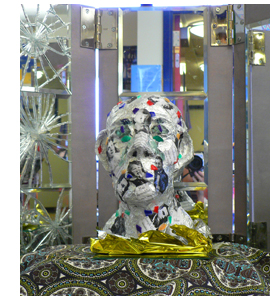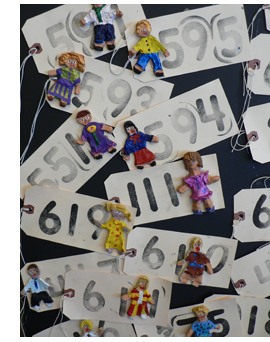With the sound of typewriter keys in the background, a group of students clustered in front of an ‘in progress’ mural, trying to determine how they will find space for the 669 luggage tags they need to incorporate. Metaphors for the rescued children they represent, it is crucial to the integrity of the work, that each tag find a suitable ‘home.’ This is the current experience of my Shoah elective class. Basing their work on the DVD “The Power of Good,” the class artists are studying the efforts of Sir Nicky Winton who, as a 29 year-old British businessman, in 1939, engineered the successful rescue of 669 Czechoslovakian, Jewish children.
Every year, I facilitate a class of middle school students who use art as the vehicle through which they study the Holocaust. Using art in this manner is a powerful learning experience. When students are younger, I prefer to use stories with an art experience as the hands on component. After reading and discussing The Butterfly by Patricia Polacco, my elementary students create butterflies decorated to demonstrate story comprehension. My older elementary students struggle to recreate the visa symbol, written by rescuer Chiune Sugihara and chronicled in the book Passage to Freedom. Combining the two themes by placing the visa symbol on a butterfly is particularly striking. Other books that provide wonderful templates for elementary Shoah art include The Lily Cupboard, Flowers on the Wall and Best Friends. Children who are students of the Shoah from a young age, are able to handle more intense work, such as recreating the artwork made by the youngsters in Theresienstadt who studied with artist Friedl Dicker-Brandeis as described in the book Fireflies in the Night.
But, for middle schoolers, whose sincere attention can be difficult to capture, utilizing collaborative art as the means to enduring learning can be an unforgettable adventure. I first began doing this, several years ago, when a school director asked me to teach about rescuers and resistance, the theme of that year’s community Yom HaShoah commemoration. I gave the students the theme, some general historical information, and many resource books, articles and pictures. They quickly decided to research one individual or organization each and represent their area of study, visually, on a large cloth banner. I was amazed by how thoroughly each student learned their own subject and how actively they taught one another and shared the process as the work progressed.
In our studio at Oakland Hebrew Day School, it has become tradition that my middle school art elective class will undertake a Shoah-based art installation each year. The piece always debuts at the community commemoration and then occupies permanent space at school. Two years ago, our Director of Judaic Studies, asked the students to create a piece that would demand that each viewer identify personally with individuals affected by the Shoah. The outcome was a magnificent, student created sculpture, that reflects viewers who study photographs wrapped around a large sculpted head. My student artists used their lunch periods to ensure that they placed photographs of family members near one another and that the experience of each Shoah victim was memorialized and shared. Even the mirrors that flank the piece were imbued with symbolism, a timeline of a shattered era progressing to a time of wholeness. Significant art learning is made concrete in the form of an artist’s statement. With collaborative work, I meet with the group and we verbally process the experience, together, before documenting it.
 Last year, my students determined the theme and engineered the project entirely themselves, using me as a supportive facilitator. What follows is their artists’ statement that accompanies their mural. As you read this and enjoy a photograph of the work, consider how your students can also truly learn about an aspect of the Shoah through art:
Last year, my students determined the theme and engineered the project entirely themselves, using me as a supportive facilitator. What follows is their artists’ statement that accompanies their mural. As you read this and enjoy a photograph of the work, consider how your students can also truly learn about an aspect of the Shoah through art:
Bearing Witness Over Time
The Responsibility of “Bearing Witness.”
We recognize that we are a unique generation. We are the last generation to have the opportunity to learn about the Shoah directly from individuals who experienced it. For some of us, this knowledge has come from our grandparents, aunts and uncles. Others of us have gained insight from speakers who have visited us at Oakland Hebrew Day School. We feel it is our responsibility now, and in the future, to “bear witness” for those who can no longer do so for themselves.Bearing witness involves more than recounting details and facts. To truly “bear witness,” involves making an experience visible, tangible and emotionally compelling.
The Responsibility of the Artist
As artists we bear a different burden than a typical historian. When we work, we bring our creativity and emotional being to the endeavor. We bring human perspectives to the raw facts. Through our art, we each reveal an individual perspective and focus while, at the same time, allowing onlookers to layer our work with their viewpoints.Art carries perpetual value. Years from now, spectators will be able to interpret the emotional content of our work as well as the factual data of the history it represents. We have used enduring symbols that have universal meaning. To understand our work does not require lengthy study. It does, however, implore you to return to it, to view its many aspects, to focus on its different regions, to re-examine the potential of what we have expressed and shared.
As 7th and 8th graders, we will soon be moving on from Oakland Hebrew Day School. Yet, we will leave this impact on the students, teachers and visitors who witness our work in future years.
The Art Problem
We were given the task of creating art-work that described the Shoah through the vision of a witness, as if, however tangentially, we too are survivors. Early on we recognized that bearing witness requires our eyes, our mouths, our hands, souls and hearts, language we invoke daily when we pray the v’ahavtah. The scope of this realization carried great significance for us, causing each of us to connect, personally and profoundly, with the task.The Process
Our research took us through historical accounts and photographs, art of post-Shoah American artists, and the art created in the Theresienstadt Ghetto.Printmaking was selected as the medium we would all use because it demands bold symbolism and a lot of physical interaction with the materials and the creation itself. Some of us traced our own hands into the work, imprinting our own selves even further into the subject. We were surprised to see, at the end, that we had each included eyes in our work.
After our preliminary sketches were completed, we drew our images onto printing linoleum and carved the designs. We printed with black and metallic inks and had a wide color selection of papers. We each completed an “edition” of 6 prints. We were responsible for personally selecting the print to be incorporated into the final piece. These final choices were made on the basis of ink quality, and contrast with the background paper.
The Outcome
For most of this project, we each worked as individual artists and it was unclear how our pieces would weave together for a communal outcome. As a group, we determined that black would give the greatest drama to our background. The prints were then mounted against a background of World War 2 photos. Just as the photos create a background for our prints, the war was the background for the Shoah. Done in black and white, the events in the photos have an almost blurred, fading effect. This represents how memories fade after a prolonged time period. In contrast, consider the bold colors of our work, demonstrating that witness accounts of the Shoah must always stand forth.As your eyes travel over the landscape of this piece, please take in the clock-works that mark the passage of time. Do take your time as you absorb the gaze of the eyes in each print. Look carefully at the position of each hand. Is that hand shielding, pushing back, or declaring? Reflect upon how the elements of fear and entrapment have been expressed in a variety of ways. We each offer you our concept of sadness, terror and the integrity of the individual through unimaginable, horrific circumstances. We invite you to add your perspective and power to the experience.
April 16, 2007
Oakland Hebrew Day School


 by
by